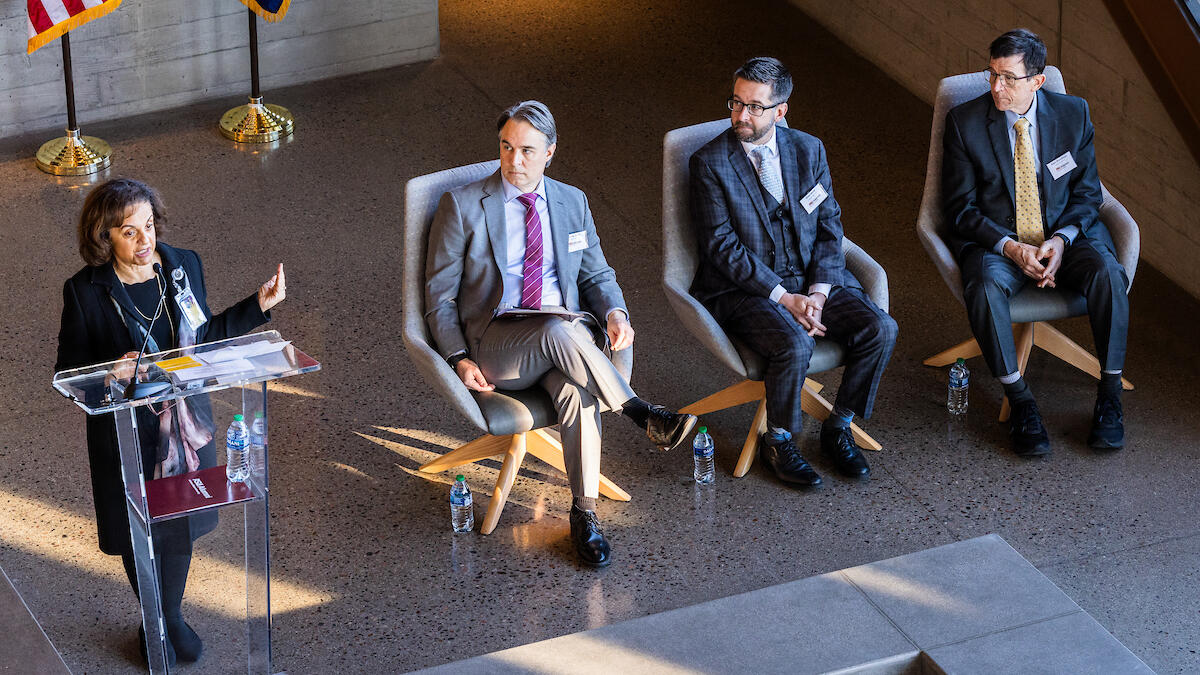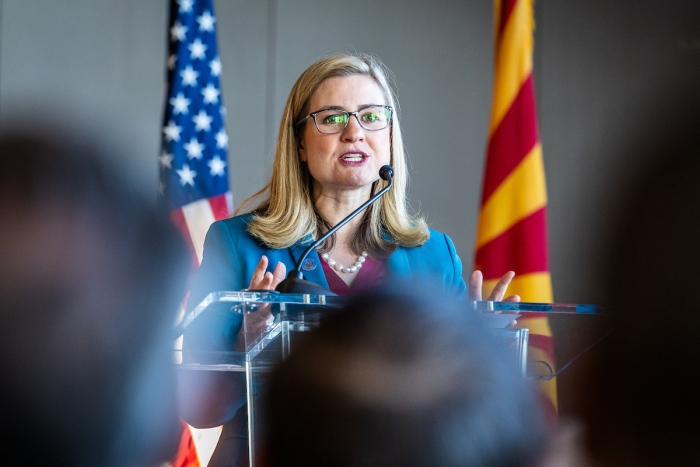ASU Health poised to be more than 'just another medical school'

Sherine Gabriel, the executive vice president leading ASU Health, moderates a panel with ASU leadership during the 2024 Sun Devil Advocacy Breakfast, which drew more than 100 community leaders on Friday, Jan. 26, at the Phoenix Bioscience Core. The annual ASU Alumni Association-sponsored event focused on the future of the ASU Health initiative. Photo by Charlie Leight/ASU News
Editor’s note: This story is featured in the 2024 year in review.
Arizona State University President Michael Crow has a running joke going with Sherine Gabriel, the executive vice president leading ASU Health.
In emphasizing the need for ASU Health to be focused, as Crow said, on “future, future, future,” he wants graduates to be better trained, more capable and more innovative.
Kind of like a fictional science fiction doctor.
“If you know who Leonard McCoy is, he’s Bones (the doctor) on Star Trek,” Crow said. “That’s who is going to graduate from the ASU medical school. We need those people.”
Crow made his remarks Friday morning during the Sun Devil Advocacy Breakfast before a crowd of more than 100 community, government and education leaders gathered at the Phoenix Bioscience Core.
Those in attendance included Phoenix Mayor Kate Gallego, Arizona Board of Regents members Gregg Brewster and Doug Goodyear, Maricopa County supervisors Steve Gallardo and Jack Sellers, as well as council members from various municipalities around the Valley.
Crow told the audience that ASU is not interested in just building another medical school that focuses on “more doctors, more doctors, more doctors.”
Instead, Gabriel said, ASU Health will bring together all of the university’s assets, from research to innovation, to improve health outcomes in Arizona.
“That’s our north star,” Gabriel said. “Everything we do is pointed towards that.”
ASU Health will include the School of Medicine and Advanced Medical Engineering, which Gabriel called a new approach to a medical school; the School of Public Health Technology; the Health Observatory at ASU, a real-time early warning system that will help state leaders spot trends and make health-related decisions based on the latest available information and data; and health care clinics throughout the state.
“We feel that kind of integration across everything that is ASU, and together with so many partners outside ASU, is what’s needed to actually move the needle on health,” Gabriel said.
“We’re not trying to build a government medical school,” Crow said. “We’re trying to build a public medical school that serves the community with a small amount of public investment.”
He also underscored the need for future ASU Health medical students to become Arizona medical professionals, rather than leaving the state after graduation.
Mayor Gallego said the ASU Health initiative is critical because the state needs more high-wage jobs in areas like bioscience and semiconductors. Also, Gallego said, “there is definitely a need for more medical professionals in the community.”
“We’ve made an intentional decision at the city to invest in bioscience and health care, going from a city that was the largest without any advanced medical education to now one that is a top five emerging life science market,” Gallego added. “There are incredible companies that are coming out of ASU and really changing our economy for the better.”
Gabriel moderated a panel discussion that included Randy Burd, who is working with ASU Health on the design and implementation of the medical school; Nate Wade, who is working with ASU Health to design and launch the public health technology school; and Neal Woodbury, chief science and technology officer with ASU’s Knowledge Enterprise.
Burd said ASU Health hopes to receive preliminary accreditation in 2025 and enroll the first class of students in the fall of 2026.
Students will do their pre-clinical work for two years, start their clinical years, clerkships and rotations in 2028, and graduate in 2030 — the same year ASU Health would achieve full accreditation.
ASU has launched a search for a dean for the School of Public Health Technology and is hoping to have a finalist in place by the summer.
In addition, ASU is beginning a public health technology corps this fall that will consist of five or six interdisciplinary students who will come together and use technology to try to help solve a public health program. They’ll work with faculty, entrepreneurs and technologists as well as local, state and federal agencies.
The goal is to launch the school in fall 2025 with three degrees: a Bachelor of Science in public health technology; a one-year master’s degree in public health technology; and a two-year master’s degree in public health with a concentration in public health technology.
Woodbury said the aim of the Health Observatory is to address the gap in data that occurred during the height of the pandemic.
“Data to be able to say as specifically as possible, ‘This is what matters. This is the thing we need to be focusing on,’” Woodbury said. “That was certainly critical when we were moving through the pandemic, and it will be critical in the future.”
ASU Health will need resources to help launch new schools, produce more doctors and nurses, and create new programs and approaches. But the payoff will be better health care outcomes in Arizona and beyond.
“Invest in the people,” Crow said. “Invest in the medical school students going to ASU and invest in initiatives like the medical school. Let’s make some great things happen.”
More Health and medicine

ASU offers bilingual counseling to Spanish speakers
Arizona is one of the five states in the nation with the highest percentage of Hispanic residents, according to the U.S. Department of Health and Human Services Office of Minority Health, and …

College of Health Solutions launches first-of-its-kind diagnostics industry partnership to train the workforce of tomorrow
From 2007 to 2022, cytotechnology certification examinees diminished from 246 to 109 per year. With only 19 programs in the United States, the cytology workforce that stands at the front line of…

ASU's Roybal Center aims to give older adults experiencing cognitive decline more independence
For older people living alone and suffering from cognitive decline, life can be an unsettling and sometimes scary experience.Arizona State University is out to improve that experience.Two projects…



